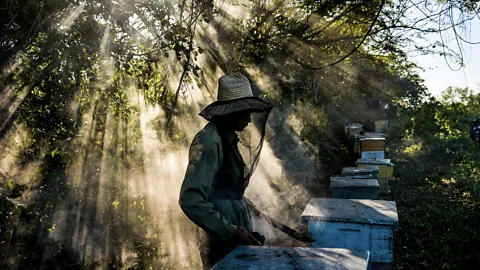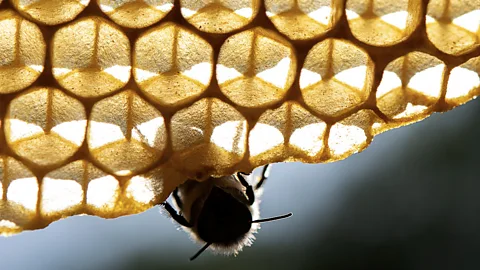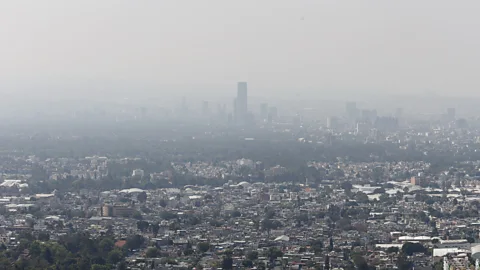 Getty Images
Getty ImagesPolluted air is not only bad for us, but it can disrupt the highly tuned senses of bees to find flowers.
In the summers of 2018 and 2019, ecologist James Ryals and his colleagues went to a farm near Reading in southern England to stare at insects buzzing around black mustard plants. One bee, hoverfly, moth, butterfly or Another insect They tried to see the pollen or nectar of the small yellow flowers, they took notes.
It was part of an unusual experiment. Some pieces of the mustard plant were surrounded by pipes that released ozone and nitrogen oxides — polluting gases produced around power plants and ordinary cars. Other parts had tubes that released normal air.
The results surprised the scientists. Plants suffocated by pollutants were visited Overall up to 70% fewer insects, and their flowers visited 90% less. compared to those in uncontaminated parts. Contaminant concentrations were far below what US regulators consider safe. “We didn’t expect it to be this dramatic,” said study co-author Robbie Girling, an entomologist at the University of Southern Queensland in Australia and a visiting professor at the University of Reading.
A growing body of research shows that pollution can disrupt insect attraction to plants—at a time when many Insect populations are currently suffering a deep decline Due to agrochemicals, habitat loss and climate change. About 75% of wild flowering plants and about 35% of food crops Rely on animals to move pollenso that plants can fertilize each other and form seeds. Even the black mustard plants used in this experiment, which can self-fertilize, showed 14 to 31 percent pollination success as measured by the number of seed pods, seeds per pod, and pod weight from plants exposed to dirty air.
Scientists are still investigating how strong and widespread these pollution effects are and how they work. They are learning that pollution can have a variety of effects, from altering the scent that attracts insects to flowers to disrupting organisms’ ability to smell, learn and remember.
The research is still young, says Jeff Riffle, a neuroscientist at the University of Washington. “We’re just touching the tip of the iceberg, if you will, in terms of how these effects affect pollinators.”
 Getty Images
Getty ImagesInsects often rely on smell to navigate. As they buzz around their neighborhoods, they learn to associate flowers that are good sources of nectar and pollen with their scents. Although some species, such as honey bees, also Use your hive pairing instructions and Visual cues such as trees For locomotion, even they depend heavily on the sense of smell to smell favorite flowers from afar. Nocturnal pollinators such as Butterflies They are especially talented. “They can sense these patches of mud from a kilometer away,” Riffle says.
One effect of pollution – and what Gerling suspects has been largely responsible for the reduction in pollination at the UK site – is how it disrupts these floral scents. Each perfume is a unique blend of dozens of compounds that are chemically reactive and break down in the air. Gases such as ozone or nitrous oxide react quickly with these molecules and cause odors to disappear even faster than usual. “For highly reactive aromas, The column can only travel a third of the distance Jose D Fuentes, an atmospheric scientist at Penn State University in the US who has simulated the effects of ozone on the scent compounds of flowers, says: “When there is no pollution, it really needs to travel.”
And if some compounds break down faster than others, the array of scents that insects associate with certain plants can be altered, potentially rendering them unrecognizable. Gerling and his colleagues observed this in experiments in a wind tunnel where they introduced ozone. The tunnel was also equipped with a device that continuously emitted a synthetic blend of floral odors (co-author Ben Langford, an atmospheric chemist at the UK’s Center for Ecology and Hydrology, says a real flower would have wilted).
Scientists were trained Honey bees Identify the main scent of the flower by exposing them to the smell, then giving them sugar water – until they automatically stick out their tongue-like tabs to smell the scent. But when bees were tested with ozone-laden odors marking the edges of the scent plume at 6 m (19.8 ft) or 12 m (39.6 ft) from the source, only 32 percent and 10 percent, respectively, ejected their proboscis. . “The bee smells a completely different odor at that point,” says Langford.
Researchers have also observed Striped cucumber beetle and Buffalo tail bees They struggle to identify their host plants above certain levels of ozone. Some of the most dramatic observations are at night, when highly reactive pollutants called nitrate radicals accumulate. Riffle and colleagues recently found out About 50% fewer moths were attracted to pale primrose. When the plant’s scent was altered by these pollutants, the white-lined sphinx moths did not detect the scent at all. The team reduced the number of seeds and fruits by 28% in outdoor pollination experiments. “It has a huge impact on the plant’s ability to produce seeds,” Riffle says.
Can insects learn to detect these altered scents? In order for insects to recognize new scents as rewards, they must smell them while feeding on sweet nectar—but the problem is that flower scent only changes at a distance from the flower. Perhaps some insects learn to follow the scent of the infected by approaching a flower. But so far this has only been shown for tobacco hawks.
“It looks like they’re potentially unable to form those memories as well and retain those memories,” Gerling says. The reason is unclear; Maybe this gas somehow causes physiological stress in the brain of bees, which leads to neurological problems. This could hypothetically mean that in polluted air, bees may forget the main scent of flowers – or, if they manage to learn it, forget the polluted scents.
 Getty Images
Getty ImagesDirty air can even affect insects’ sense of smell. A few years ago, a chemical ecologist Megali is profitable French Center for Functional and Evolutionary Ecology and his team He attached electrodes to the antennae of buffalo tail honey bees and fig bees. They found that exposing insects to ozone often made these olfactory organs much less responsive to odors. Bees and bumblebees exposed to moderate levels of ozone moved aimlessly and not toward the odors of their host plants.
At high ozone levels, fig bees even avoided “There’s something going on in their olfactory system,” says Beau Proffitt.
Air pollutants also have an effect when plants absorb them: they can change the plant’s metabolism and thus change the composition of the odor compounds that flowers emit, says ecologist Laura Duke at the University of Würzburg, Germany. Depending on the species, Ozone can increase or decrease the number of flowers and possibly the quality and quantity of nectar or pollen. Duke says ozone can also affect flowering time. If there is a complete mismatch between flowering and insect activity, there may be no plant reproduction at all.
Elsa Youngstedt, an urban insect ecologist at North Carolina State University, who wrote a 2023 paper on pollination in cities, says it’s difficult to assess the extent of these effects on plant pollination. Annual Review of Ecology, Evolution and Systematics. Only a few studies—including Girling’s study in Britain and Riffle’s study of butterflies—have determined quantitative effects.
In general, Youngstedt says, the biggest impacts are expected to be in cities, which have suffered the most pollution since industrial times – although this may also lead to adaptations. Studies of non-urban plants and insects “may provide a different picture than when we study plant and insect populations that have already been exposed to urban pollutants for hundreds of years.”
 Getty Images
Getty ImagesAlso, the effect of pollution on insects is unclear. When insects fail to recognize flowers, they miss an opportunity to obtain nectar or pollen for themselves, their young, or their hives. They have to travel farther in search of floral scentsIt drains their energy, Fuentes says.
Pollution can also affect insect reproduction and survival in general. Putting all these effects together, a recent study estimates that Air pollution reduces pollinator performance by more than 30%. Scientists need more research on different species, on their susceptibility to pollution and their interactions with plants – especially in areas such as the Global South.
From agricultural chemicals to climate change, “we have all these other factors that are causing loss and reduced fitness, making it harder for these insects to go through their normal life cycles and normal processes,” Gerling says. “If you make the flower a little harder to find, is that the tipping point that pushes that particular bug or hive over the edge?”
* This article It appeared first in Knowable magazine, and is republished under a Creative Commons license.
If you liked this story, Sign up for The Essential List newsletter – A hand-picked collection of can’t-miss features, videos and news, delivered to your inbox twice a week.
Follow us for more science, technology, environment and health from the BBC Facebook and X.
#air #pollution #kill #pollinating #bees
